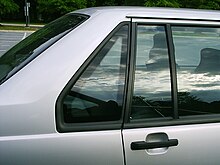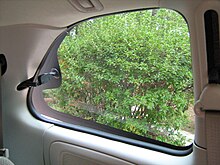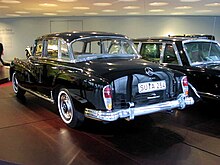Quarter glass


Quarter glass (or quarter light) on automobiles and closed carriages may be a side window in the front door or located on each side of the car just forward of the rear-facing rear window of the vehicle.[1] Only some cars have them. In some cases, the fixed quarter glass may set in the corner or "C-pillar" of the vehicle. Quarter glass is also sometimes called a valence window.[2]
This window may be set on hinges and is then also known as a vent window, wing window, wing vent window, or a fly window. Most often found on older vehicles on the front doors, it is a small roughly triangular glass in front of and separate from the main window that rotates inward (see top right image) for ventilation.[3]
Designs
[edit]Many early closed cars, such as the 1933 Pontiac Economy Eight had front and rear vent windows called "ventiplanes" and were installed on all GM products that year. It has hinges and a latch, so it can be opened for additional ventilation. 1933 was the first year all GM vehicles were installed with optional vent windows which were initially called "No Draft Individually Controlled Ventilation" later renamed "Ventiplanes" which the patent application was filed on 28 Nov. 1932. It was assigned to the Ternstedt Manufacturing Company, a GM subsidiary that manufactured components for Fisher Body.[4]
Most vehicles since the 1960s have removed this feature for cleaner styling known as "ventless" windows. Some automakers continued to offer vent windows with the American Motors made AMC Pacer having optional front vent windows for increased flow-through ventilation.[5] Although the front venting windows "provide unmatched ventilation, air turbulence and leakage outweigh the benefits".[6] As automobile air conditioning became more popular, front window vents disappeared by the 1980s.[7]
Some vehicles also have glass that rolls down like a regular window or have hinged opening vent quarter windows for rear seat passengers. During the 1980s, the Lincoln Town Car had a version where the vent window would retract into the door separately from the primary side window, so that the vent window would always drop down first and was the last to return after the main window was rolled back up. The Toyota Century had vent windows that would pivot out, and were operated with a dedicated electric switch for the front and a separate vent window in the rear doors.[8] This may be a side window between the B-pillar and the C-pillar, and in the case of US minivans between the C and D-pillars (examples include the Chrysler Town and Country power-operated venting glass).[9]
A quarter glass can be found set in the body or A-pillar ahead of the front door opening (examples include the Buick Encore, Chevrolet Lumina APV, Toyota Prius, Opel Astra J, Mitsubishi Endeavor, Fiat Grande Punto, Suzuki SX4 sedan, and the 8th-generation Honda Civic sedan). They are non-movable and mounted in the door itself because that section of the rear side glass would not be able to slide down because of the cut-out in the rear doors required to clear the rear wheel housings. The fixed portion of the glass is separated from the main window that rolls down by a slim opaque vertical bar (see top left image of a close-up of rear door).
In some automobiles the fixed quarter glass may set in the corner or "C-pillar" of the vehicle. There are also designs that incorporate two quarter windows (see bottom left image) one that is part of the door and the second mounted in the roof pillar. This arrangement may help to increase driver visibility. In this case, the quarter glass in the C-pillar would not be called an "opera window". Non-opening, fixed quarter windows are installed like windshields in that they are bonded to the body with urethane.[10]
-
Two non-movable quarter windows of a Volvo 940, one as part of door and a second mounted in the C-pillar
-
The Toyota Prius has both front and back non-venting quarter glass
-
The Mercedes-Benz 300d is a rare example of a vehicle with a fully removable rear quarter window. Called a "parade limousine", removal of its final triangular pane created an unbroken expanse to the rear of the car, allowing crowds to see dignitaries seated in the back.
See also
[edit]References
[edit]- ^ Severson, Aaron (15 August 2009). "From Pillar to Post: More Automotive Definitions". Ate up with motor. Retrieved 18 April 2015.
- ^ "Auto Parts Guide – 'Q'". getusedparts.com. 2005. Archived from the original on 14 March 2006. Retrieved 18 April 2015.
- ^ "Vent Windows on Your Car: Function of Vent Windows". Safelite.com.
- ^ Kimes, Beverly (1996). Standard Catalog of American Cars 1805–1942. Krause Publications. pp. 1217–1232. ISBN 0-87341-478-0.
- ^ "The Pacer and the Rabbit: A Tale of Two Subcompacts". Michigan Living – Motor News. 57–58: 10. 1974. Retrieved 18 April 2015.
- ^ Dunne, Jim; Hill, Ray (February 1976). "Intermediate sedans – big cars of the future". Popular Science. 208 (2): 44. Retrieved 18 April 2015.
- ^ Winte, Matt (23 December 2014). "10 Old Car Features We Desperately Miss". automoblog.net. Retrieved 9 September 2024.
- ^ "Glass Removal and Installation, Page 1 (Automotive Tutorials)". Auto body tool mart. Archived from the original on 22 March 2015. Retrieved 18 April 2015.
- ^ AAA Autotest: New Vehicle Evaluations for 1994. American Automobile Association. December 1993. pp. 219 & 229. ISBN 9781562510916. Retrieved 18 April 2015.
- ^ Mills, Walter Ray (2011). Auto Glass Technical Training Manual. Newnan, GA: Lulu.com. p. 121. ISBN 9781300751281. Retrieved 18 April 2015.




